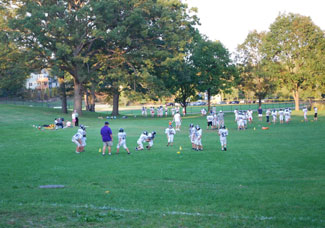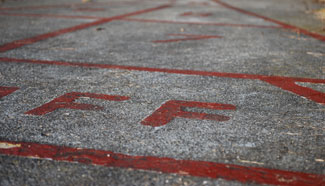West Park Improvements Discussed
By the time the presentation was in full swing, close to 40 people had streamed into a ground-floor meeting room at Miller Manor to hear city of Ann Arbor park planner Amy Kuras, plus a supporting cast of consultants, sketch out options for improvements at West Park and listen to reaction from residents. Residents and planners alike might have disagreed on the specifics, but there seemed to be a consensus on at least one point: the future of West Park should be filled with activity.
On the way to the meeting, The Chronicle stopped to take in a current West Park use: football practice for a four-school coalition of area Catholic schools (St. Francis, St. Thomas, Spiritus Sanctus, and Huron Valley), which together field one varsity and one JV squad, which play in Detroit’s Catholic Youth Organization league.
The varsity team has compiled a record of 4-0 so far this fall, with the JV even at 2-2. They will play for the district championship this coming Sunday, Sept. 28 at Gabriel Richard field – 12:30 p.m. game start for the JV, with the varsity contest slated to begin at 2:30 p.m. Details about the scrimmage were supplied to The Chronicle by Gina Walsh, whose sons Kevin and Jack help quarterback the varsity and JV teams, respectively, and whose son Charlie patrols the sidelines as the water boy. Football practices in West Park with this four-school coalition are the result of an effort that Doug Busch helped lead (of the grocery store Busch’s) to provide an opportunity parents felt was missing.
Although the boys ranged from 5th through 8th grade, the coaching staff were giving them a full dose of instruction in football technique. “Square up your butt!” was the last lesson taught before The Chronicle headed up the hill to Miller Manor for the West Park meeting.
As Kuras summarized the discussion from the first public meeting on West Park improvements – held in July – the tension became clear between the need to manage natural features (like water) and the desire to feature amenities that support various activities (from baseball to bandshells). Water management consultant Don Tilton spoke of segregating recreational activity areas from the kinds of bioswales, wetlands, and other non-structural storm water management options that were available. Tilton stressed that they were not approaching the challenge of drying out the soggy areas intended for recreation with the idea of just adding more pipe. There’s already plenty of pipe under West Park, some of it a conduit for Allen Creek, which in a different epoch flowed along the surface.
Instead of more pipe, the kind of ideas currently contemplated by Tilton are reflected on the drawings by what one resident called “a pearl necklace of blue going through there.” That is, a swale that might sometimes be filled with flowing water. It emerged in the discussion that Prof. Chris Ellis of the University of Michigan’s School of Natural Resources and Environment currently has some graduate students working on the design of wetlands for West Park that would have a filtering function for storm water – an opportunity for city-university cooperation.

Robert Wagner, Executive Director of Lurie Terrace, explains to Amy Kuras, city of Ann Arbor park planner, a vision for a return of shuffleboard to West Park.
Among the amenities that residents seemed to support was the idea of seat walls terraced into the hill facing the bandshell. Another idea that does not seem to require choosing one amenity over another was proposed by Robert Wagner, Executive Director of Lurie Terrace (a nearby senior housing complex): refurbish the existing shuffleboard court adjacent to the tennis courts. Wagner went to the easel to point out exactly where the court was located, and said he’d be willing to invest in new shuffleboard equipment for his residents. He described a future where the shuffleboard courts of West Park might tap into the competitive spirit between Miller Manor and Lurie Terrace.
Yet another idea that on its face would not require sacrificing some other amenity came from Mike Levine: an edible West Park. Levine wasn’t talking about a Project Grow garden plot. He meant plantings of pear trees, apricot trees, and various berry bushes that residents could pick and eat as they walked the trails through the park. He alluded to apricot trees in downtown Ann Arbor that already provide nice fruit … to residents who know where they are. The Chronicle is hoping for some tree-map tutoring from Mike.
The possibility of a Project Grow garden did come up, and Executive Director Melissa Kesterson outlined what the criteria were for garden plot site selection: (i) residents have to want them there, (ii) it must be flat, (iii) a water source must be available, and (iv) sunshine must be abundant. Baseball players in the audience perceived a choice between preservation of the West Park baseball field and a Project Grow garden plot, with one baseball supporter suggesting that Ann Arborites could already grow whatever extra vegetables they wanted in the strip of land between the sidewalk and the street. In one sketch, the baseball diamond had been replaced with a soccer field – a sport described by that same baseball supporter as “un-American.” “Any game where you can’t use your hands to touch the ball is just stupid!” he said, apparently only half kidding.
His fellow baseball supporter, Jay Jahnke, who manages the upper and lower division Ann Arbor A’s, pointed out that there are 22 teams that play baseball at the field, and that “it’s the best place to play baseball in lower Michigan,” due to the sight lines and the backdrop, not to mention having a storied history of baseball played there. So Jahnke was somewhat underwhelmed by Kuras’ assurance that if the baseball diamond disappeared from West Park, it would be replaced at a different location.
Towards the end of the meeting, one resident brought the discussion back from baseball around to the question of what the long-term provisions are for water management in the West Park master plan. What happens if the non-structural strategies for segregating wet and dry areas don’t succeed? Part of the answer has to do with what happens farther upstream from West Park, but there was nothing definitive to say. Which is why there will be at least one additional public meeting on West Park improvements. As one resident had phrased the challenge earlier in the meeting, “Mother Nature always bats last.”






Berries are good, and (when that time of year comes) I have a pretty good urban foraging map.
But apricots? Do tell.
I attended this meeting and took lots of notes. Could have saved myself the effort–the AA Chronicle did it for me. Excellent article.
It was also an excellent meeting. All the stakeholders were there, spoke and listened to each other with courtesy and a willingness to reconsider their opinions. The baseball player who first objected to the community garden, for instance, expressed support for the garden when Kuras showed how it would not conflict with the diamond. The soccer field, however, would.